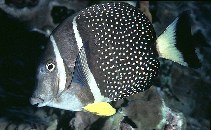| Family: |
Acanthuridae (Surgeonfishes, tangs, unicornfishes), subfamily: Acanthurinae |
| Max. size: |
26 cm TL (male/unsexed) |
| Environment: |
reef-associated; marine; depth range 0 - 10 m |
| Distribution: |
Indo-Pacific: oceanic islands in the western Indian Ocean to the Hawaiian, Marquesan and Tuamoto islands, north to the Ryukyu Islands, south to New Caledonia and Rapa. |
| Diagnosis: |
Dorsal spines (total): 9-9; Dorsal soft rays (total): 27-30; Anal spines: 3-3; Anal soft rays: 23-26. Preserved color is brown; spotted, white spots usually bordered with dark brown (may help conceal it in turbulent water that is often filled with small bubbles). Pelvic fins bright yellow. Each side of caudal peduncle with a single, sharp, forward-pointing erectile spine. Gill rakers on anterior row: 21-24; gill rakers on posterior row: 19-23. |
| Biology: |
Occurs in surge zone of clear seaward reefs (Ref. 9710, 58302). Benthopelagic (Ref. 58302); mainly oceanic and found schooling in shallow depths over reef flats subject to surge or currents (Ref. 48637). Browses on filamentous and calcareous algae. Forms schools. |
| IUCN Red List Status: |
Least Concern (LC); Date assessed: 03 May 2010 Ref. (130435)
|
| Threat to humans: |
harmless |
Source and more info: www.fishbase.org. For personal, classroom, and other internal use only. Not for publication.
